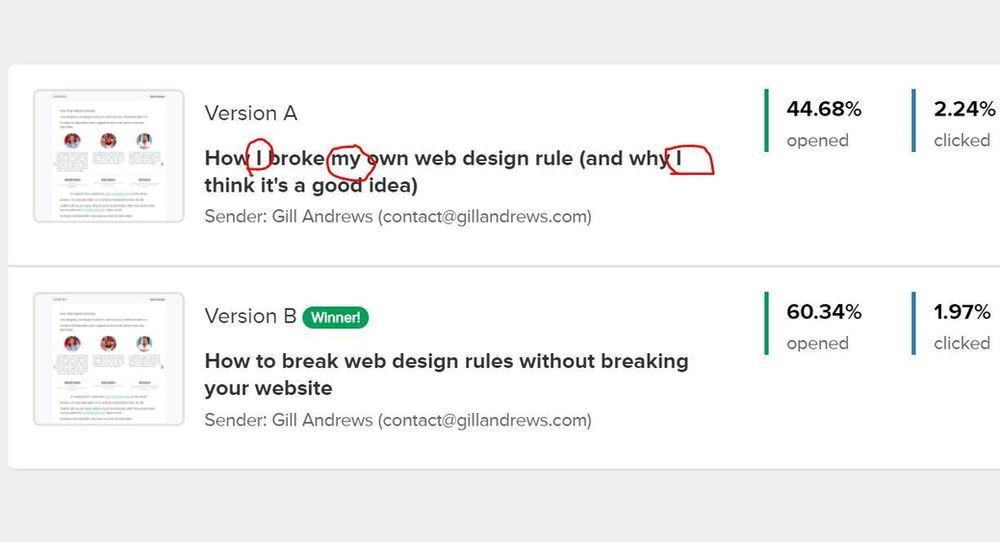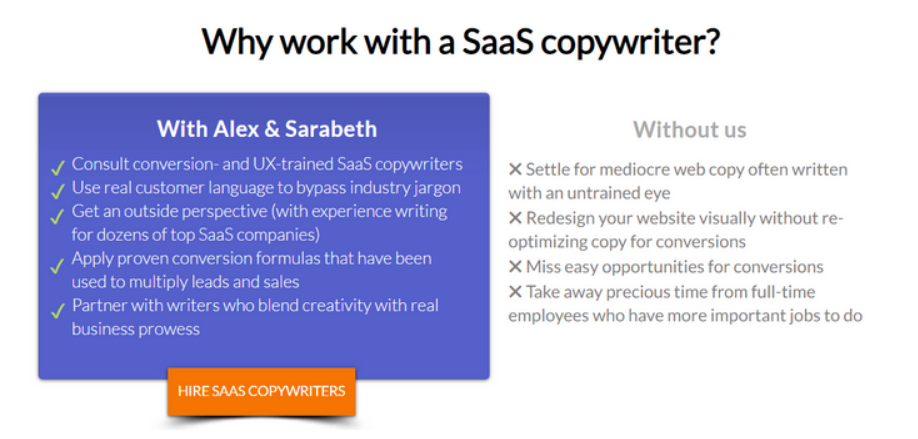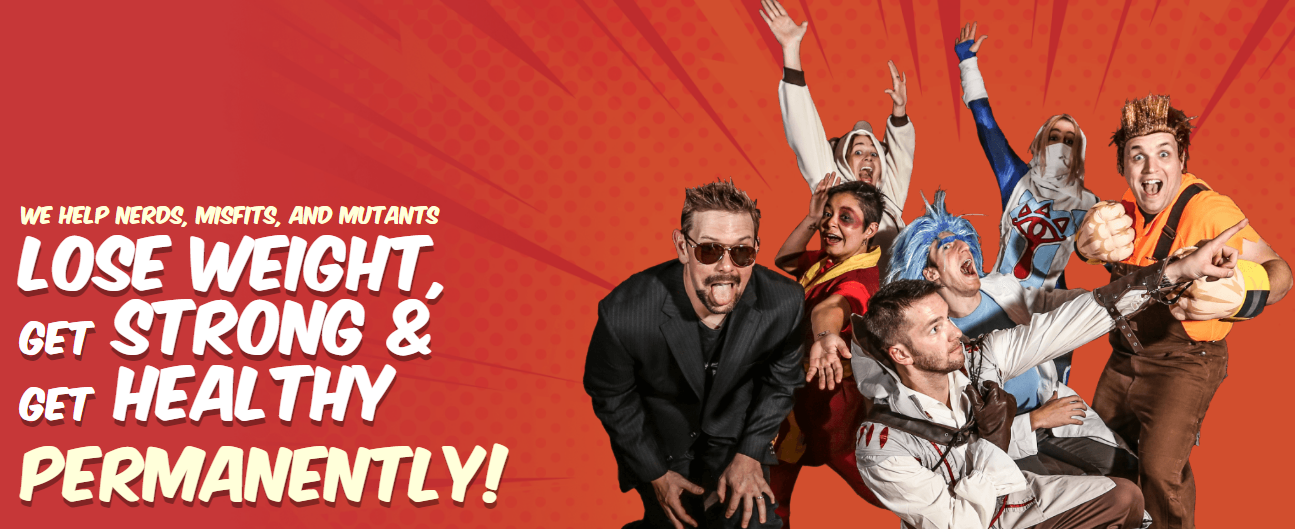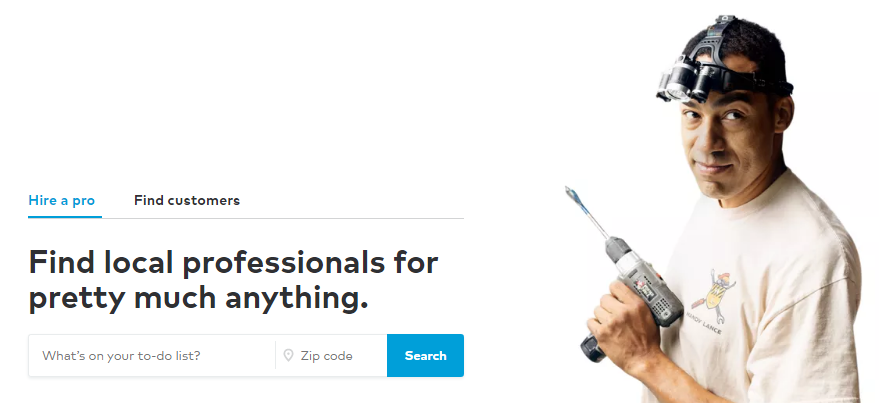Copy is the bread and butter of any website, especially for SaaS companies. The wrong words can confuse your visitors, causing them to leave your page without the specific action - such as signing up for your product. Conversely, good copy will keep them reading until the very end, increasing the chances that they'll become a paying customer.
SaaS Copywriting can be challenging. You need to make sure you're highlighting the right features while
still appealing to potential customers, and it all has to be translated into a language that everyone can understand.
With that in mind, here are twelve essential things you need to contemplate while writing a SaaS website copy:
1. Know your customer
When writing your website copy , it's essential to consider whom you're writing for. While this may seem like a no-brainer, it can be easy to get lost in the technical details of your product and forget that there are real people on the other end of the page.
It's also vital to factor in that people have different learning styles. Some people prefer visuals, while others like written instructions. Whatever your product is, you need to tailor your website copy to match the way your audience wants to learn about it.
The most efficient way to conduct customer research is by speaking and connecting with your customers. This can be attained in two ways: run surveys or schedule interviews.
Kofi Group is an excellent example of connecting with the customer in their language. They decided to target the customers at their most vulnerable with a slogan and placed it on the home page.
Since the majority of the candidates go for big multinationals and startups are rarely considered to work at due to the risk involved, Kogi Group offers special hiring services to align prospects with startups so that everyone gets an equal shot.

Source: Kofi Group
2. Use The Language of Your Readers
Since you’re writing to address your customers, they will be reading your copy. Hence it would help to use their language, the language they understand, while referring to them. No customer will show care towards your company unless you show care towards them first.
Instead of using a we-centric language, try using a customer-centric language. The difference between the two can be pretty subtle, like using verbs at the beginning of the sentence, ensuring that the audience is the centre of the attraction.
Following is an example by a SaaS copywriter which speaks for itself.

Source: Gill Andrews
And just in case it is necessary to add your name to the website copy, you can still do so while being customer-centric, just like Ahref did in the image below.

Source: Ahrefs
Even though they did not use a verb at the beginning of their sentence, they managed to keep their copy customer-centric by keeping their customer at the focus of the action while mentioning a pain point: increased traffic and better ranking.
The best SaaS companies’ websites serve the customer rather than the customer serving the website. And what better way of serving a customer than by mentioning it clearly and loudly.
3. Use Simple And Clear Terms
If you want a strong brand recall and want your audience to retain what you’ve just told them: USE SIMPLE TERMS. Using simple and straightforward language, telling stories, painting a picture, or using analogies will help the audience connect and resonate with your web copy.
Business jargons are vague and complex. The biggest issue with using business jargon is that the audience can go through the entire content without actually learning anything about your business or retaining any useful information.
Just like how ClickUp beautifully blends simplicity and visuals to create a striking statement on their website. The statement, “One app to replace them all”, along with imagery, immediately attracts the attention of the audience.

Source: ClickUp
However, if you are writing for B2B SaaS Companies, it may be challenging to ignore technical jargon due to the discussion of technical tools. This is the reason that we have put together a few SaaS copywriting tips for you.
- When you start your conversion-optimized SaaS copy, it may sound complex at the start, but later on, you can minimise the confusion by using simple everyday language
- Clear, emotional and painting a positive image will help your copy be more memorable to your audience even after they have left your website.
- No one likes to read long walls to texts. Readers prefer reading short words, sentences or stories
4. The Fear of Missing Out
People are always afraid of missing out, whether in their personal or professional life. They like to relate to the experiences of their friends, family and acquaintances. And good SaaS copywriters can perfectly encash this to induce such fear into the audience.
A good approach to do so is by using a comparison table, which can do wonders. Because a comparison table allows the audience to skim through easily while evaluating both converse situations, that is, with and without your product or service.
On one side of the table, you can brag about your services or products, while on the other side, you may list general industry practices using competitor products or services. Moreover, if you don’t like using tables, you can do so without using a comparison table. Take the example of LCW, which is a great example of a FOMO copy.

Source: LCW
This isn’t just a subtle but a loud and clear comparison too that you may either waste hundreds of bucks over advertisements or earn by running successful campaigns—just one sentence, yet so compelling.
5. Write At The Level Of Your Customer’s Understanding
It's important to know that this is not a one-size-fits-all solution. It's important to know the level of understanding your customer has to provide them with the right content. The better the understanding you have of your customers, the better you can explain SaaS companies or products to them, which will surely give you a competitive edge over your rivals.
If you have recently come up with an innovative solution or a new SaaS company, it is important to build awareness first. This step includes building credibility and trust as well as educating your customers. For this, you can also make use of social media platforms, and you don’t need to be on your toes to do so, thanks to all the social media management and scheduling tools available.
Suppose the market you operate in is already very populated, in such a case. In that case, traffic is your solution, and for which you need to diversify yourself from your rivals, using SaaS website copy for conversions.

Source: Nerd Fitness
Nerd Fitness is a perfect example to differentiate yourself from the competition. If you look at a regular fitness advertisement, you would see a mainstream fit guy in a shirtless picture, and the overall theme of the ad would most likely be in a serious and go-get-them tone.

Conversely, Nerd Fitness pushed away from mainstream expectations and highlighted playful normal people in funny costumes with a light-hearted, inclusive theme.
So, how can you put forward a USP? The easiest way is to look at reviews and pick out all positive elements of your product or service. Next, turn to your rivals’ reviews and see which of your positive elements can overshadow their negative reviews. This is one of the easiest ways to build a strong USP.
6. Include the human side without leaving out the business side.
Writing for B2B SaaS companies, keep in mind that your audience is human; even if your customers are businesses, those businesses are also run and handled by human beings only. Hence, make sure your copy includes emotions; you can add humour while being casual and conversational.
Let the audience know that you are more than just spreadsheets or technical jargon. After all, you, a human, is drafting the SaaS website copy for conversions , and you are not a writing AI. And best way to prove that the person behind this copy is a human is by pouring your personality into the web copy.
Make reading fun for your audience, let them enjoy the process, and remember to celebrate the audiences’ success as your own. Mingle with them, let them know you, and let yourself know them as well.
You can take inspiration from Intercom. They have perfectly aligned their tone–conversational, with the solution they offer, which is a marketing platform. Even if your personality may not be your USP, having one will surely differentiate you from the competition.
7. Easen Up The Purchasing Process
While clarity is the key to conversion, it is contrasted with confusion. So without adding unnecessary complications and confusions, convey to the customers your offerings in a clear manner.
Buying from your website should be one of the easiest tasks for your prospects, which means adding a value-driven yet clear call to action. Adding unnecessary complications in this step may make you lose on a prospect.
One of the best SaaS copywriting examples is Thumbtack. They precisely convey their offerings and immediately call you to solve your problem, which is their call to action. Instead of using a generic call to action, like try it for free, they placed a search bar to ease down the process for the visitors.

Source: Thumbstack
Instead of placing the call to action at the bottom or a separate page and making the purchasing process busier while potentially losing on prospects, place it on the home page or at a place where it is easy and convenient for the customer to take action without rummaging around.
8. Testimonials and Social Proofs
Making claims is very easy. We have witnessed the most bizarre claims there can be because it is easy to do so, don’t tell us that you’ve never heard at least once about a freak claiming to be a time traveller. However, people tend not to believe such claims, not because they are bizarre, but because there isn’t enough supporting evidence.
Similarly, claiming to be the best in the industry isn’t enough to buy the customer’s trust unless you really are and have supporting evidence. And the best way to do so is by demonstrating social proof. Social proof is a popular practice across the industry. However, the downside is that the most common
social proof is word of mouth, which has lost its credibility due to being commercialised.
Permanently cementing the notion of social proof into your audience's mind might be worth considering. But how can you make it stand out and captivate the prospects’ attention?

Source: Proposify
Proposify demonstrates a perfect SaaS copywriting example. Instead of focusing on the company, Proposify shifted the focus to the customers’ experience. Contrary to the majority of the SaaS companies.- Who list big publication names as featured in or vast customer profiles as trusted by.
This way, not only did Proposify add social proof to their website, but it also appreciated their customers, increasing customer satisfaction.
Social proofs help you celebrate your success, and what better way to celebrate it than by celebrating your customers.
9. Highlight Benefits
Customers are usually hunting for solutions to their problems. A good SaaS copywriter understands so and highlights how your product or service will help solve problems and benefit the customers.
You may make a long list of unique features of your product or services; however, it may not be useful if it isn’t presented correctly to the customer or perceived correctly by the customer.
A really good SaaS copywriting example is DropBox. Rather than listing down their features, DropBox explains how they can solve the customers’ problems because it is easier for a customer to understand how the product will benefit them than it is to understand the product's features.
However, this doesn’t mean that the features should be completely eliminated from the copy. Rather place them in a less obvious place.
10. Search Engine Optimization
One of the most effective ways to increase web traffic is Search-Engine Optimization. But not even content or web copy can generate traffic; there are certain checkpoints to tick for your content and website to be optimised to show up at higher search engine ranks.
Using well-researched keywords enables prospects to look up and reach out to your website more easily. However, the checkpoints don’t end here; getting your website or content ranked higher and better at a search engine is more than just the right and well-researched content. You have to make the search engines believe that the content that you produce is the best and what people are actually looking for.
Researching for keywords include using keyword tools such as Ahrefs or Google to evaluate a keyword. Moreover, you will also have to look for keywords at your rivals’ websites too. You can find keywords placed in meta descriptions and titles, URLs and header tags.
Adding their keywords alongside your well-researched ones puts you a step ahead, improving rankings and increasing traffic flow. Experts recommend using keywords once or twice, though optimal keywords may differ between pages and phrases. However, the basics of the keywords may even generate a large amount of competition to improve rankings.
11. Determine Goals and Objectives
Before getting started to writing for B2B SaaS companies, you must define the goals and objectives. SaaS companies have SMART goals, and so do their websites. These objectives can either be separate for businesses and websites or a combination of both.
Business goals may include better conversion rates, improved customer service, and increased leads. However, such goals aren’t quantified; the better, the merrier. These objectives are set by mutual understanding between the shareholders and management.
On the other hand, website goals, which include improved traffic flow, or increased page visits, help ensure that business goals are met. The assessment of the progress of these goals is measured using web analytical tools. And setting the current metrics are a base, plans are formed for more goals and objectives to be met.
12. Measure Website Health
Measuring and analysing the current metrics of your website, such as visitors, time spent, bounce rate, conversion rate, and leads to evaluate the current health of your website. The health of your website is based on the functionality, design of web pages, and performance.
And these results must be compared to your rivals too, to evaluate the performance of your website as well as your business. For which you can make use of analytical tools like Ahrefs Crazy Egg Google Analytics.
And to improve your website, evaluate current gaps that need to be improved or updated while highlighting the strengths.
Conclusion:
Copy is a crucial part of any website, but it can be especially crucial for SaaS companies. SaaS copywriting can be difficult. There are many things to consider, and it can be easy to make a mistake. This article went over 12 essential things to keep in mind when writing website copy for a SaaS company and provided SaaS copywriting tips. We hope you find this information helpful! Alternatively, you may even get in touch with Writing Services Hub to get professional copies written right off the bat.